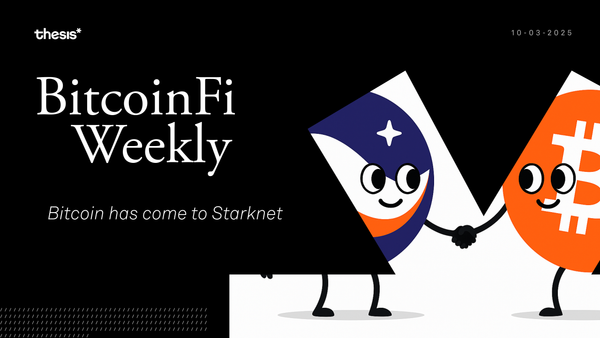Your Bitcoin Can Now Pay Your Mortgage
Imagine a “self-paying mortgage” that weaves your Bitcoin collateral into real estate financing so you can borrow without sacrificing your long-term upside.

Welcome to BitcoinFi Weekly. We cover where people use their BTC and what is changing in the Bitcoin world.
You’ve been hodling Bitcoin like a pro—cold storage, no keys, no regrets. But let’s be honest: staring at a hardware wallet isn’t exactly finance. What if your sats could moonlight as a down payment on a house, back a municipal bond, or even outsmart the IRS? On today’s edition of BitcoinFi Weekly, we ask: What if Bitcoin… did stuff?
Here’s this week’s rundown:
🏠 Feature Piece: Exploring Bitcoin Utility Through Real Estate and Bonds
⚡ Strata Productizes BitVM2
🚫 US Customs Seizes Bitcoin Mining Rigs
⚔️ Swan Fights Back
🎲 OP_RAND Debate Continues
Feature Piece: Exploring Bitcoin Utility Through Real Estate and Bonds
Let’s imagine you have a big stack of Bitcoin sitting in cold storage. You bought some every month, like clockwork. You’ve studied the Bitcoin halving, grown accustomed to the drama of its price swings, and politely declined requests to cash out. You do not want to sell, or maybe you promised yourself you never would. Yet a lingering question persists deep in the recesses of your mind: what is the point?
In the early days, “using your Bitcoin” often meant stuffing your coins into a web wallet, risking every Satoshi on a sketchy exchange, and hoping for the best (s/o Poloniex, my beloved). Most people learned that self-custody was safer. But just holding your coins in self-custody can feel static. But that is all changing. In 2025, the big Bitcoin narrative will be: keep those coins in your control while still generating yield. To what end, you may ask? One compelling application is the “self-paying mortgage,” a structure that weaves your Bitcoin collateral into real estate financing so you can borrow without sacrificing your long-term upside.
A mortgage is a simple thing: you post the house as collateral, the lender gives you the principal, and you make payments over time. With a “self-paying mortgage,” you add your Bitcoin as a second layer of reassurance. If the price of Bitcoin rises, your risk profile shifts, and your interest rate might decline. If Bitcoin’s price falls, you aren’t liquidated out of your home, because the house itself is still your main collateral. That keeps you from losing your precious coins when the market wobbles. You keep the upside and mitigate the biggest fear of a margin call.
Now, let's expand the demo outside of individuals and institutions. Let’s start at the city level: consider a “Bitcoin bond.” Traditionally, a bond is dull: you buy government or corporate debt, collect some interest, get principal back when it matures. Over time, inflation whittles down the value of that principal. Now imagine a bond whose underlying assets are part Treasuries and part Bitcoin. The structure is straightforward: You raise $100 million, put $80 million in Treasury notes yielding 4.5%, and use the other $20 million to buy Bitcoin. After five years, the Treasuries mature into $100 million, so investors get their principal back. The “floor” to protect principal is built from the safer portion. Meanwhile, if Bitcoin’s price goes up substantially, that slice might deliver an impressive yield. Hence, your hypothetical bond pays you a base rate if Bitcoin flounders, but it can deliver a significantly higher yield if Bitcoin’s price climbs. This is clever in several ways:
- Cities get to offer bonds with unlimited upside
- Investors get principal protection
- The city's credit rating matters more than Bitcoin's volatility
- Everyone gets to feel innovative while using a pretty standard principal-protected note structure
The pitch to investors is "this is a normal muni bond except you might get rich." The pitch to cities is "you can attract new investors and probably get better rates."An interesting feature of these bonds is that they create a reflexive cycle: When Bitcoin goes up, the bonds yield more. If the bonds yield more, more cities will issue them. If more cities issue them, they'll buy more Bitcoin. If they buy more Bitcoin, Bitcoin will go up. This is the sort of logic that makes Bitcoin people very excited. However, the noteworthy thing is that it would make Bitcoin functional rather than just valuable. The bonds would use Bitcoin as an input to produce municipal financing rather than sitting there being scarce. The fascinating thing about the municipal approach is that it starts small. Everyone talks about national Bitcoin adoption, but cities can move faster than countries. Naples, Florida (which has a AAA credit rating) could issue a Bitcoin bond before the US Treasury figures out what Bitcoin is. This creates a natural laboratory. Some cities will try Bitcoin bonds. Others will watch. The successful ones will be copied. The unsuccessful ones will be blamed on idiosyncratic factors. This is how financial innovation usually works.
Yet all these solutions remain early. Building new credit structures around a volatile digital asset is challenging. Automated liquidations were the first attempt, and they can be brutal—nobody wants to see their coins sold in a flash crash. That is why a lot of the conversation is shifting toward dual collateral: put up a house, or a city budget, or something robust from the “normal” world, then sweeten the deal with Bitcoin. The normal world knows how to handle real estate. The normal world likes well-rated municipal bonds. Pairing the stable side of finance with a little bit of Bitcoin’s volatility can produce a yield that outruns inflation yet doesn’t force you to exit your position. In the background, the markets still do their usual dance, but you stay calmly on track.
Of course, these “active” approaches to Bitcoin can become elaborate. People conjure everything from paycheck conversions (do your entire payroll in BTC, if you dare) to bridging tokens that let you move Bitcoin across multiple chains. The underlying hope is that if Bitcoin is an excellent store of value, it should do more than sit inert. If you want to use that store of value for building a house, financing a public project, or earning an interest-like return, you should be able to keep the direct upside. You can aim to become the one who borrows cheap dollars while storing real “hard money.” You are effectively your own mini Federal Reserve—minus the money printing, plus a stash of cryptographic keys locked in multisignature.
This entire question of “active Bitcoin usage” always circles back to self-custody. A Bitcoin ETF or a big custodial platform might have simpler sign-up forms. They might look friendlier to those just starting out. But if your primary reason for being in Bitcoin is to claim sovereignty and mitigate the wobbles of fractional reserves, then it’s worth investigating ways to hold your coins while still leveraging them. A Bitcoin-based mortgage or a partial-collateral bond can be as intuitive as any typical financial product once mainstream institutions develop a more direct integration. But until then, specialized outfits have begun forging solutions for the early adopters.
Whether you are borrowing against your coins to keep them or harnessing them inside a structured product, the message is straightforward. A new market is forming for full-reserve, cryptographically verifiable loans and bonds, powered by a digital asset that thrives on not being forcibly sold. Yes, you can remain that unwavering HODLer. But if you’re open to a Bitcoin-based interest rate, a self-repaying mortgage, or a yield curve that incorporates a dash of BTC’s upside, you can pivot into more active ways of holding. For an increasing number of people, that’s the real next step for Bitcoin—making it live in everyday finance. When that shift takes hold, Bitcoin will occupy a more central place on people’s balance sheets.
BitcoinFi Updates
Strata Productizes BitVM2
ZK-focused Bitcoin platform Strata announced significant improvements to BLAKE3 implementation within BitVM2, enhancing its efficiency for SNARK verification on Bitcoin. Lots of acronyms, I know. Let me explain.
BitVM2 works by breaking down verification proofs into smaller segments that can run within Bitcoin's scripting language. A key component of this system is SNARKs, which are cryptographic proofs that allow efficient verification of computations. To make these proofs work effectively on Bitcoin, Strata uses BLAKE3, a cryptographic hash function that helps securely pass data between proof segments.
Strata has optimized its BLAKE3 implementation, expanding its processing capacity from 288 bytes to 1024 bytes per operation while improving efficiency. An internal review is underway, with plans to upstream the improvements for broader use within the BitVM ecosystem, benefiting protocols like Strata's bridge.
US Customs Seizes Bitcoin Mining Rigs
Blockspace Media exclusively reports U.S. Customs and Border Protection (CBP) has begun seizing Bitcoin mining ASICs from manufacturers Bitmain, MicroBT, and Canaan at multiple ports of entry. This initiative stems from a request by the Federal Communications Commission (FCC) and follows last year’s detainment of Bitmain’s Antminer S21 and T21 models, which allegedly utilized restricted AI chips sourced from Sophgo. The most recent seizures, documented in CBP records obtained by Blockspace, invoke U.S. legal code 19 USC 1595a(c)(2)(A), referencing unauthorized communications equipment and noncompliant radio frequency devices.
The expanded enforcement has resulted in significant seizures, including one reported case involving $5 million worth of equipment. The scope of these holds has expanded beyond previously affected ports to encompass additional points of entry nationwide. Taras Kulyk, cofounder and CEO of Synteq Digital, indicated that nearly every major Asian ASIC vendor is encountering customs issues. The seizures are particularly significant given that Bitmain, a Beijing-based company that moved manufacturing outside China after 2018 tariffs, controls approximately 80% of the ASIC market.
Swan Fights Back
Swan Bitcoin provides savings plans, instant buys, private client services for businesses and HNWI, Advisor Services for financial advisors, and Bitcoin education. Recently, Swan filed an objection in the Prime Trust bankruptcy case, challenging the Plan Administrator's motion to classify certain assets as part of the bankruptcy estate. According to Swan’s filing, Prime Trust was contractually obligated to segregate and protect Swan’s reserve funds, which represent a small portion of Swan’s total holdings; customers retain custody through other platforms like Bakkt, BitGo, and Equity Trust. Prime Trust allegedly failed to uphold its fiduciary duties by mixing customer funds, leading to concerns that these assets might be improperly treated as part of the bankruptcy estate.
Swan argues that the assets were always the property of its clients, evidenced by explicit contracts and separate account statements. The company further cites Bitcoin’s ledger as proof that these funds can be traced, contrary to claims they are “hopelessly commingled.” The Plan Administrator’s motion to include these assets among Prime Trust’s own bankruptcy liabilities, Swan contends, ignores established procedures designed to handle disputes over customer-held property. Swan CEO has explicitly confirmed that no customer funds are at risk in this matter.
OP_RAND Debate Continues
In a prior newsletter, we covered what OP_RAND is and how it functions on Bitcoin by arranging a trustless interactive protocol between two transacting parties. This debate on Delving Bitcoin has explored extending the recently proposed OP_RAND implementation to Lightning Network use cases, particularly for handling small-value payments. The core idea involves replacing trimmed HTLCs (currently used for economically unviable payments) with probabilistic payments. For example, instead of sending 1 sat directly, the system could create a 10,000 sat payment with a 1-in-10,000 chance of success.
Several challenges were identified, including the computational overhead of transmitting large numbers of hashed public keys for each payment, concerns about transaction structure security, and debates about whether probabilistic payments should be limited to only small-value transactions. Some developers argue that the approach could also be valuable for larger payments in complex channel structures where onchain settlement costs are high, though others suggest improving the underlying technology might be more beneficial than implementing probabilistic solutions.
For Lightning Network users, this means we could soon have a mathematically fair way to send tiny amounts of Bitcoin (like fractions of a cent) without requiring trust or incurring high fees.
Closing Thoughts
We find ourselves at a curious inflection point in the evolution of money. The future is orange: mortgages become self-paying, and city bonds incorporate Bitcoin's volatility. At the same time, we witness the emergence of a new pattern: the merging of two previously distinct systems of value. Traditional finance is beginning to interweave with Bitcoin's wild oscillations. The result is neither purely onchain nor purely traditional, but rather a complex adaptive system where stability and volatility dance together.
If there's a topic you’d like us to cover or have questions, reach out at [email protected].
Learn more about Mezo at the following channels:
👾 Discord: https://discord.mezo.org
🕊 X: https://twitter.com/MezoNetwork
🖥 Website: https://mezo.org
🏦 Deposit Portal: https://mezo.org/hodl
ℹ️ Docs: https://info.mezo.org





